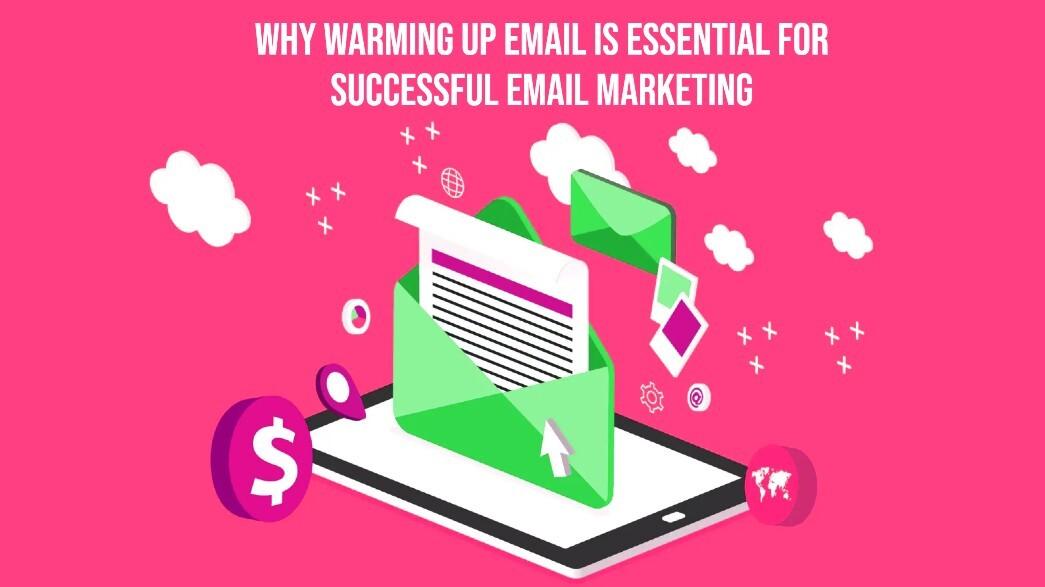
Why Warming Up Email Is Essential for Successful Email Marketing
Get it warm or lose the charm
Email Warmup
Get it warm or lose the charm
Published:
Email Warmup
Hafsa Channa
Share

Are your email marketing campaigns failing to get the results you want?
If so, it may be time to consider rethinking your strategy and giving some extra attention to warming up new accounts. Developing a rigorous warmup period for any new account before launching a full-scale email campaign is critical for effective, successful email marketing.
Not only will this prevent your emails from falling into the spam folder or landing in the dreaded "Promotions" folder, but it will also better equip you to target specific audiences with personalized messages that improve engagement rates.
In this blog post, we discuss why warming up accounts should become part of all digital marketers' strategies and include helpful tips on how exactly one should go about doing so.
The email warmup process is essential to ensure your emails land in recipients' inboxes and to improve the reputation of your email account.
This process includes tasks such as sending and receiving warmup emails, establishing relationships with contacts you often communicate with, marking important emails, and more.
The initial period of warmup takes about 8-12 weeks, but you must continue to practice "warming up consistently" techniques in order to keep your good standing and maximize your potential for deliverability.

Don't neglect the importance of an email warmup – it's one of the best ways to ensure that all your important messages get read!
Email warmup is an important process for any type of email account, whether personal or promotional.
By properly warming up your account, you can make sure that your emails will be delivered directly to the intended recipients' inboxes without issue. The email service provider and internet service provider need to analyze an account's history and reputation before allowing them to send out a larger quantity of emails.
A positive reputation is the key to becoming trustworthy. Because of this, it is essential to build your reputation by creating a "positive history" prior to the full-scale rollout process. Warming up your account correctly can go a long way in ensuring that emails are delivered reliably and on time.
Also Read: How Does Email Domain Warm Up Work?

The email warm-up helps achieve improved email deliverability. Utilizing this solution ensures that your emails are allowed passage through spam filters and get right into the recipient's inbox. It works by checking your email history and the engagement of users who have already received emails from you. Automated email warm up like what GoCustomer offers exchanges human-written emails from thousands of verified, trustworthy email accounts with your email domain. This helps build your sender reputation.
So if you've just set up a new email account (or revisited an old one), it's important to take these steps before launching your mass cold email campaigns. Otherwise, your cold emails could easily end up blocked as spam. You can improve your email deliverability with an email warm-up tool such as GoCustomer and experience better results for your cold email campaigns.
Starting an email warm-up service is essential for those looking to maximize their daily sending limits. Every email service provider has its own set of rules regarding how many emails you can send daily. For example, Google Workspace sets a limit of 2000 outgoing emails per day but will not allow a fresh email account to use this capacity straight away.
Instead, the ESP needs first to assess the impact of just a few emails on recipients - it looks at measures such as bounce rate or open rate. It uses this data to build a positive reputation for the sender before allowing them to send out more emails. By gradually ramping up the frequency and amount of messages sent out each day, you can eventually reach your maximum capacity.
When it comes to email marketing, optimizing the open rate of your campaigns should be a top priority. This can be achieved through an email warm-up process that allows you to safely reach more people in your email list.
With a properly warmed-up email account, you will be in a prime position to get the most out of your campaigns and maximize engagement from your target audience. So if boosting your open rate is one of your main goals, make sure to prioritize warm-up as part of your strategy and start seeing the results.
When it comes to email, your online reputation matters. ESPs (email service providers) like Gmail, Outlook and other email providers have specific rules to evaluate a sender's reputation to ensure their users have the best experience possible. As soon as you create an email account, your reputation is neutral – so your job is to start building it right away!
That's where email warmup comes in – it's the process of proactively building your reputation so that the ESPs view you as a trustworthy sender. Actions such as sending and receiving a few emails daily contribute towards building a positive reputation.
Having a good reputation will increase the chances that your emails show up in people's inboxes, as opposed to their spam folders – and that's every email marketer's goal!

There are a few steps to email warmup:
Securing your email account with email authentication helps to protect your emails from being blocked by spam filters and prevents email spoofing. The main components of this security system are SPF, DKIM, and DMARC.
SPF records in the Domain Name System specify which servers can send emails on behalf of your domain.
At the same time, DKIM ensures that any messages between your account and a recipient's inbox remain authentic and uncorrupted.
Moreover, DMARC plays an additional role in keeping data secure by facilitating authentication reporting for any suspicious emails sent under your domain name. With email authentication, you can stay confident that your communications remain secure and protected against cyber threats at all times.
If you're serious about maintaining your email and IP reputation, you should consider switching from a shared IP address to a dedicated IP address. Dedicated IPs give you more control over your reputation since no other accounts will be sending emails through it – this means that malicious activities carried out by others won't affect your IP reputation.
Plus, utilizing a dedicated IP gives you more flexibility in customizing your warming-up process and allows you to respond quickly to any changes impacting your email delivery. So if you're looking for a surefire way to give yourself the best possible chance at good email deliverability, don't hesitate to switch to using a dedicated IP!
Using a custom domain is the way to go when sending out emails. Not only is it more trustworthy than generic email accounts, but it also provides you with more control over your email reputation.
If your IP address gets damaged, you can simply switch it out and fix the domain reputation in no time. With an authentic custom domain, recipients will be confident that their emails are from a reliable source. Investing in a custom domain for your email sends is an effective way to protect your business and its customers.
Having a custom domain for email campaigns has clear defined advantages. For starters, it's easy for your audience to memorize; instead of having to remember a string of letters and numbers, they're now only accessing one place when they want to read your emails.
This is an especially great option if you plan on switching ESPs down the line and still want to use the same name! And let's not forget that a personalized domain adds an extra dose of professionalism and trustworthiness. People will be more likely to open emails from unique domains, making your campaigns all the more successful.
When it comes to sending out emails, content is key. Having high-quality and trustworthy email content that resonates with your audience is imperative for successful emails.
If your emails look spammy or are not relevant to the recipients, they may end up in a filtered-out box or, even worse - reported by users - this would negatively affect your email reputation. While writing compelling copy may require some marketing prowess, there are several ways you can improve your content right away.
Make sure the subject line is specific to what you are trying to communicate, and avoid using generic phrases like "news update." Use language that will grab the reader's attention and make them want to open your email.
Optimize preheaders is a great way to give readers a sneak peek of what they can expect when they open your email. Preheaders should be concise and interesting enough to make them curious about the content inside.
Proper formatting is key in the email content. Use short paragraphs, headings, bullet points, and other visuals to break up large pieces of text and make it easier for readers to scan through your message quickly.
Links are an important part of any email content; however, avoid generic CTAs like "Click here" or "Find out more" as these don't tell the recipient anything about where they will be taken if they click on the link.
Instead, provide relevant context so that readers know exactly what action to take after clicking on your link.
Lengthy emails may seem overwhelming, but if done right, adding more words and details can help create an engaging experience for recipients by helping them better understand your message or product/service offering.
Include extra facts and figures related to the topic of discussion in order to support your claims and provide value-add information to keep recipients engaged throughout the entire length of the email.
When crafting emails, it's important to be mindful of the words you use. Spam filters are particularly discriminating when it comes to risky words such as "FREE," "% OFF," and "BUY RIGHT NOW." Overusing these phrases can negatively impact your mail deliverability and even taint your email reputation.
Smart Insights did a case study looking into email deliverability and concluded that using spammy words is one of the major factors in being blocked by spam filters. To ensure proper email warm-up and avoid triggering spam filters, try to restrict your use of this type of language.
Also Read: How to Determine the Best Time to Send Emails
Email warming up is essential to successful email marketing – there's simply no way around it. By following the best practices for warm-up, you can ensure that your emails will be delivered appropriately to your recipient's primary inbox and that your sender's reputation stays strong.

Reach more customers with your cold emails
Table of Contents
In a nutshell

Subscribe to our Newsletter!
Digital advice costs money but we send it to
your inbox for free.

Related Blogs


Book a quick demo of our email marketing tools and watch as we transform your leads into loyal customers.

![A loop illustration w-auto h-[70px]](/_next/image?url=%2F_next%2Fstatic%2Fmedia%2Fvector1.7738e6de.png&w=256&q=75)
Get in touch
Subscribe to our weekly Newsletter and receive updates via email.